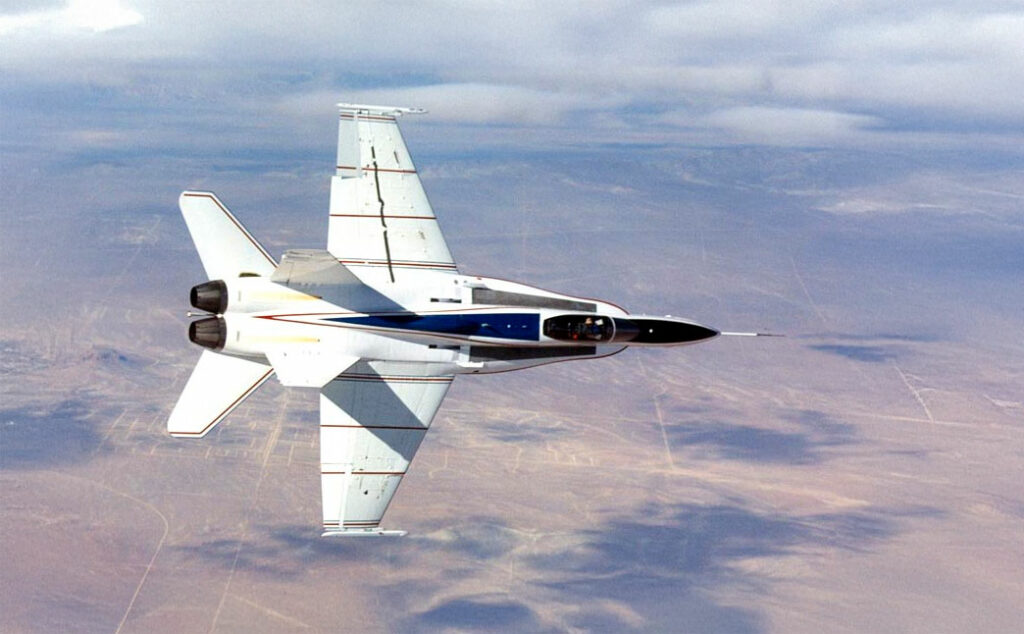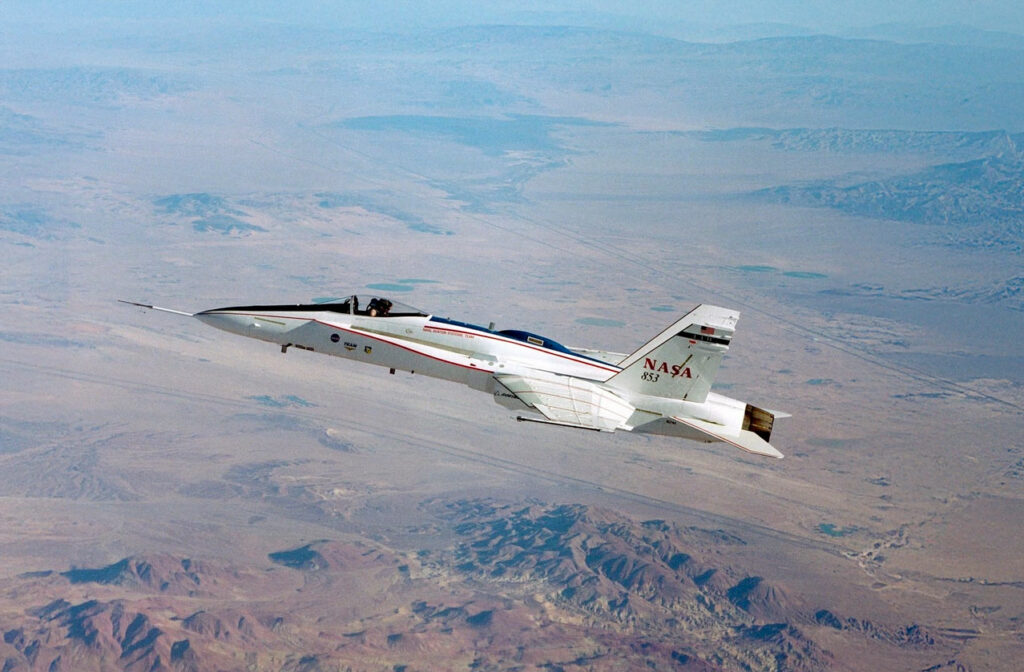The Boeing X-53 AAW tests adaptive wing control technology, enhancing flight performance by minimizing traditional control surfaces.
In brief
The Boeing X-53 Active Aeroelastic Wing (AAW) is an experimental aircraft designed to test a cutting-edge wing technology concept. This technology allows the wings of an aircraft to flex during flight to improve aerodynamic performance. The X-53, based on an F/A-18, uses active wing control surfaces and structural flexibility to reduce drag and improve efficiency. The Active Aeroelastic Wing concept was created to minimize the reliance on traditional control surfaces like ailerons and rudders, which usually induce additional drag. Instead, the X-53’s flexible wings respond to aerodynamic loads in flight, adjusting the wing’s shape for optimal performance. This advanced control system reduces the energy needed for flight control, offering potential improvements in fuel efficiency, range, and maneuverability. The project was a collaboration between NASA, Boeing, and the US Air Force, aimed at testing this technology for future aircraft applications.

The Boeing X-53 AAW (Active Aeroelastic Wing)
The Boeing X-53 AAW is a significant experiment in aircraft design, aiming to enhance flight control and performance through advanced wing flexibility and structural innovation. To understand its development, we need to place it within the context of evolving aeronautical engineering in the 1990s. During this period, the aerospace industry was in search of innovative solutions to improve aircraft efficiency and performance, particularly for military applications. The key issue was the inherent limitations posed by conventional control surfaces, which create drag and limit the aircraft’s performance at high speeds. To tackle this, engineers began exploring ways to use the natural flexibility of the aircraft structure to improve aerodynamics. The result was the Active Aeroelastic Wing (AAW) program.
The AAW program was launched by NASA in collaboration with Boeing and the US Air Force in the mid-1990s. The project’s goal was to develop wings that could actively flex in response to aerodynamic forces, allowing for improved flight control without increasing drag. This represented a major shift from traditional aircraft design, where rigid wings were controlled by ailerons, flaps, and rudders. The program was intended to demonstrate how these adaptive wings could improve fuel efficiency, increase maneuverability, and extend the operational range of future military aircraft.
The X-53 program began as a modification of an existing F/A-18 Hornet, a well-established US Navy multirole fighter. The F/A-18 provided an ideal platform for testing the AAW concept due to its agility and well-documented performance characteristics. The first flight of the modified F/A-18 took place on November 15, 2002. This test flight marked the beginning of an intensive testing program that would investigate the viability of flexible wings for future aircraft.
Unlike conventional wings, which remain relatively rigid during flight, the X-53’s wings were designed to bend and flex in response to aerodynamic forces. This allowed the aircraft to control its flight path using smaller control inputs, reducing drag and energy consumption. By using this technology, the X-53 was able to achieve more efficient flight performance compared to traditional designs. It provided a new approach to aircraft control, opening up possibilities for future designs that could benefit from increased fuel efficiency and enhanced combat capabilities.
Although the X-53 did not receive a NATO nickname, it was a key part of the US Air Force’s and NASA’s ongoing efforts to push the boundaries of aircraft technology. By focusing on the interaction between aerodynamic forces and wing structure, the program sought to lay the groundwork for future innovations in both military and civilian aviation.
Design of the Boeing X-53 AAW (Active Aeroelastic Wing)
The design of the Boeing X-53 AAW was focused on integrating active aeroelastic wing technology into an existing airframe, making use of flexible structural elements and advanced control systems to optimize performance. Based on the F/A-18 Hornet platform, the X-53 differed from the standard model in several key areas.
One of the central innovations was the use of aeroelastic tailoring, where the wing structure was intentionally designed to flex under aerodynamic loads. This design allowed for the minimization of traditional control surfaces such as flaps and ailerons. The wings’ ability to twist and bend during flight allowed for real-time aerodynamic adjustments, reducing drag and improving efficiency.
The wings of the X-53 are constructed using lightweight composite materials, ensuring that they are both strong and flexible. These materials allowed the engineers to design wings that could withstand significant aerodynamic loads while also being able to flex appropriately. This construction is critical for achieving the objectives of the AAW program, as the flexible wings must be both durable and responsive to maintain control during flight.
In addition to the materials used, the X-53 featured a sophisticated control system. The aircraft’s flight control computers were programmed to monitor and adjust the wings’ flex in real time, responding to changes in aerodynamic forces. This system used sensors to detect aerodynamic loads on the wings and made continuous adjustments to maintain optimal performance. The system’s ability to actively control the wing structure was a significant departure from traditional flight control methods, which rely on rigid wings and movable control surfaces.
The major advantage of the X-53’s design is the reduction in drag, which leads to improved fuel efficiency and extended range. By eliminating the need for large control surfaces, the aircraft can maintain a smoother aerodynamic profile. This translates into less resistance from the air, allowing the X-53 to fly faster and more efficiently than traditional aircraft designs.
However, there were also challenges associated with this design. The reliance on wing flexibility means that the structural integrity of the wings is of critical importance. The wings must be strong enough to withstand the forces exerted during high-speed flight, but flexible enough to adapt to changing aerodynamic conditions. Finding the right balance between flexibility and strength was one of the primary technical challenges of the X-53 program.
Performance of the Boeing X-53 AAW (Active Aeroelastic Wing)
The Boeing X-53 AAW’s performance was significantly shaped by its innovative design and the inclusion of the Active Aeroelastic Wing technology. This section will provide an in-depth analysis of its engine, power, speed, altitude, and range metrics, as well as compare the aircraft to its competitors in the military aircraft domain.
The X-53 was powered by two General Electric F404-GE-400 afterburning turbofan engines, the same engines used in the F/A-18 Hornet. Each engine provided 16,000 pounds of thrust (71.17 kN). The engines’ thrust combined with the aircraft’s reduced drag from its flexible wing design contributed to higher fuel efficiency and better overall flight performance.
In terms of speed, the X-53 was capable of achieving Mach 1.8 (1,191 mph or 1,917 km/h). While this is comparable to other fighter aircraft in its class, the key advantage of the X-53 was its ability to maintain high speeds with lower drag. This efficiency gave it a potential edge in long-range missions, where fuel economy becomes a critical factor.
The X-53 could operate at a maximum altitude of 50,000 feet (15,240 meters). This high-altitude capability was essential for reconnaissance and combat missions, allowing the aircraft to fly above enemy air defenses and engage in air-to-air combat with improved situational awareness.
The range of the X-53 was approximately 1,200 nautical miles (2,222 kilometers), with the possibility of further extending its operational range through aerial refueling. While this range is not significantly higher than other fighter aircraft, the fuel efficiency gains from the Active Aeroelastic Wing could allow for more extended operations without needing to refuel.
In comparison to its competitors, the X-53 was not the fastest or most powerful aircraft, but it offered a significant advantage in terms of efficiency. Aircraft such as the F-22 Raptor or the Eurofighter Typhoon, while more advanced in terms of stealth and avionics, did not incorporate the same level of aerodynamic efficiency as the X-53. This made the X-53 an ideal candidate for missions where range and fuel economy were prioritized over raw power or speed.
Variants of the Boeing X-53 AAW (Active Aeroelastic Wing)
The Boeing X-53 AAW was primarily a technology demonstrator, and as such, did not produce many variants. However, it went through several modifications during its testing phase.
- X-53A (Base Model): The X-53A was the original aircraft used for testing the Active Aeroelastic Wing concept. This variant was a modified F/A-18 Hornet, retrofitted with flexible wings and an advanced control system.
- X-53B (Enhanced Performance Variant): A proposed variant aimed at improving the efficiency of the active aeroelastic wings further. It was designed to test higher flexibility in more demanding flight conditions. However, this variant was not fully developed beyond the planning stage.

Military Use and Combat of the Boeing X-53 AAW
The X-53 AAW was not intended for direct combat but was instead a technology demonstrator. Therefore, it was never armed with traditional fighter jet weaponry like missiles or machine guns. However, its potential applications in military aviation were significant, particularly in terms of efficiency and range for future aircraft design.
There is no record of the X-53 being used in any military conflict, as it remained a research project throughout its operational life. Its purpose was to explore new technologies for improving the aerodynamic performance of military aircraft. Nonetheless, the data gathered from the X-53 program could influence the design of future combat aircraft.
While the Boeing X-53 AAW was never deployed in active combat, its contributions to military aviation research were substantial. The project demonstrated the feasibility of integrating flexible wings into future aircraft designs, which could provide significant advantages for military missions requiring high fuel efficiency, long range, and superior maneuverability. The aircraft was a part of the United States’ broader effort to explore advanced flight control technologies, potentially informing the design of next-generation fighter jets, bombers, and reconnaissance aircraft.
Though the X-53 itself was not armed, future military aircraft based on its principles could be equipped with a range of modern weapons. These could include air-to-air missiles such as the AIM-120 AMRAAM, air-to-ground precision-guided munitions, and other advanced armaments designed for multirole fighters. The flexible wing technology could allow such aircraft to carry out extended missions with fewer refueling stops and perform complex aerial maneuvers more efficiently than current aircraft models.
In terms of competing aircraft during the development of the X-53, platforms like the F-22 Raptor and Eurofighter Typhoon were notable contemporaries. These jets were developed with a focus on stealth, speed, and agility, incorporating advanced avionics and weapons systems. However, neither aircraft focused on the level of aerodynamic efficiency brought by the X-53’s Active Aeroelastic Wing concept. As a result, while the X-53 lacked the stealth or advanced radar systems of the F-22, its efficiency-based approach could serve as a complementary technology in future aircraft design. It would allow for missions that prioritize fuel conservation, long-range engagement, and reduced radar cross-sections through more efficient aerodynamics.
Despite the lack of direct combat involvement, the X-53 remains a valuable reference for military aviation programs worldwide. The research conducted during its test flights could influence future developments in both manned and unmanned aircraft, especially for long-duration reconnaissance missions and fuel-sensitive operations like air refueling or extended patrols. Though the X-53 was never sold to other countries, the technological insights gained from the program have likely been shared within NATO and other allied nations. It is also plausible that elements of the Active Aeroelastic Wing technology have been studied by other aerospace programs internationally, potentially influencing the design of future military aircraft across the globe.
By the late 2000s, the X-53 AAW was phased out as an active research platform, as newer technologies such as stealth, artificial intelligence, and autonomous flight began to take precedence in military aviation research. Its legacy, however, persists in ongoing efforts to improve aircraft efficiency through structural flexibility and adaptive control systems.
Back to the experimental aircraft section.